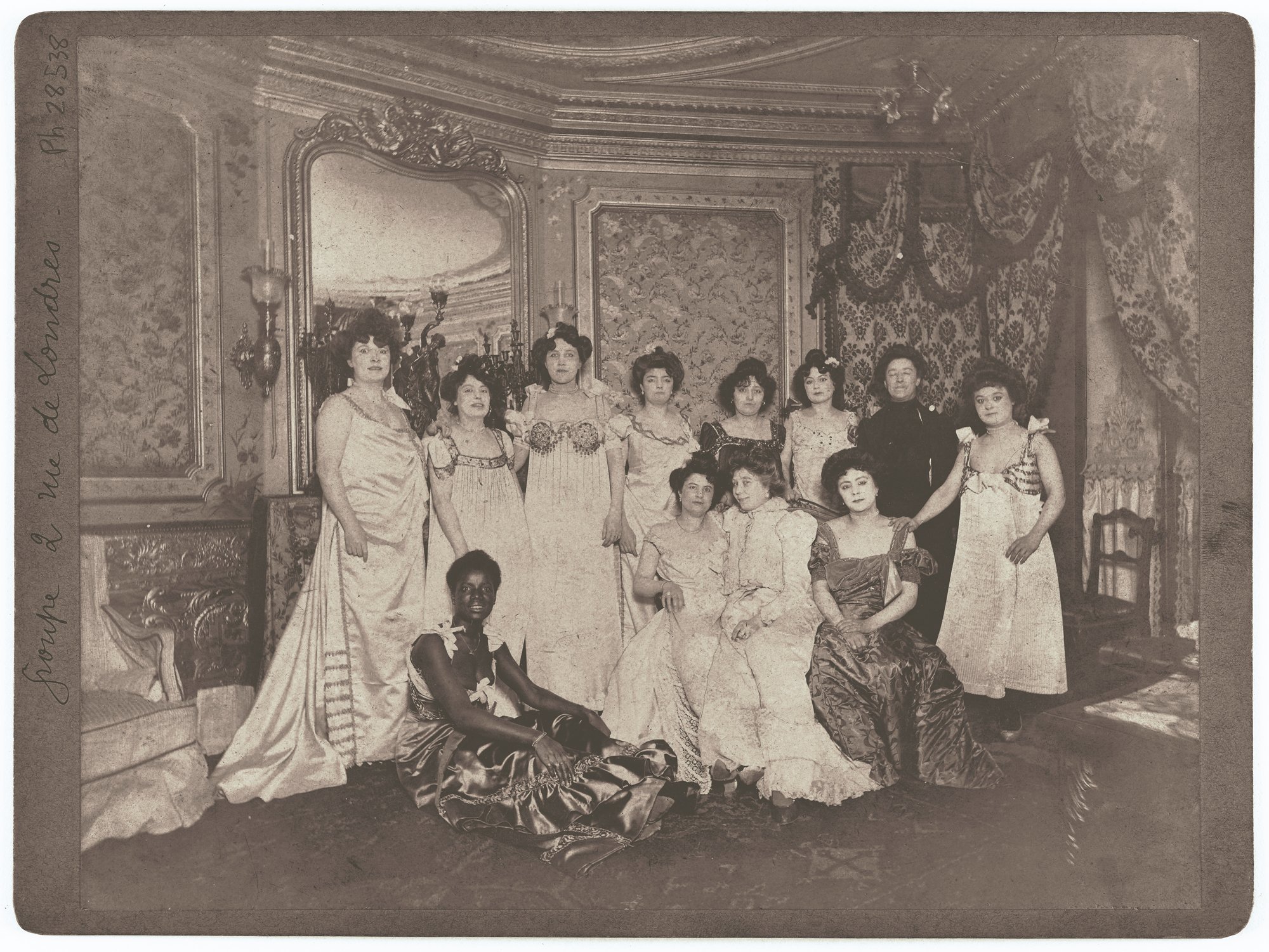Tales From Gropecunt Lane
Author: Kate Lister
Excerpted from Harlots, Whores & Hackabouts: A History of Sex for Sale
To sex workers everywhere, past, present and future.
Albert Brichaut, Maisons de Tolérance, c. 1900.
Women posing in the maisons de tolérance located at 2 rue de Londres. Copyright Musée Carnavalet.
In the autumn of 1888, five women were brutally murdered in the Whitechapel district of London, England. Despite the best efforts of Scotland Yard, their attacker was never caught. Mary Ann “Polly” Nichols, Annie Chapman, Elizabeth Stride, Catherine Eddowes and Mary Jane Kelly are now known as the “canonical five” victims of the serial killer the British press nicknamed Jack the Ripper. Their murders were reported around the world and birthed an international obsession with their killer. In life, Polly, Annie, Elizabeth, Catherine and Mary were unremarkable. Like thousands of Londoners living in desperate poverty, they eked out an existence on the margins of society, but, in death, they attained an almost cult-like status in popular history, as countless historians, authors and amateur “Ripperologists” have tried to unmask their killer. Every year, tourists still flock to Whitechapel to walk the same streets as the killer once did, take in a Ripper tour or visit the Jack the Ripper Museum. The Ripper is now part of British folklore and continues to evoke hackneyed images of dimly lit streets, swirling smog, a shadowy figure and, of course, the “prostitutes” that he preyed upon.
The impoverished women who sold sex in the slums of Whitechapel are as much a part of the Ripper mythology as the killer himself. The canonical five may be infamous, but they have never been “real” women to us. As the Ripper became legendary, his victims became little more than a sensationalist plot device in the story of their murderer. Despite hundreds of books, documentaries and websites dedicated to uncovering the identity of Jack the Ripper, the identity of his victims has never extended much beyond the effacing label of “prostitute.” They too have become caricatures: hiding in doorways, their faces drawn and pale, their lips rouged, hitching their tattered skirts up past their ankles to reveal a flash of cheap stockings, calling out to clients in the broad, Cockney tones of old London town, and offering sex for the price of a jar of gin or maybe a night at the dosshouse.
The narrative demands that these women were “prostitutes” in the same way it demands that their killer was somehow mysterious and extraordinary. But Hallie Rubenhold’s recent research into the lives of the canonical five suggests that only Elizabeth Stride and Mary Kelly had earned their money by selling sex. The others, like many in the slums of Whitechapel, were homeless and earned their money through a combination of odd jobs, begging, borrowing and pawning what few possessions they acquired. Rubenhold’s claim fundamentally disturbed the foundations of the Ripper narrative and led to her receiving considerable online abuse from “Ripperologists” certain that these women were selling sex because of the poverty they endured. This hostility has laid bare an ongoing determination, both in their own time and today, to make these women stereotyped, cartoon “prostitutes,” in order to fit a more salacious narrative.
Interiors of ‘Blue Books’, c. 1906–08
Copyright Historic New Orleans.
The stigma surrounding sex work and sex workers has long blinded us to the reality of these women and others like them. Today, sex work is a diverse and complex experience, ranging from full-service sex workers to dancers, sugar babies, BDSM providers and those selling photos on OnlyFans. All sell a sexual service, but few would call themselves a “prostitute.” Conversely, many Victorians comfortably labeled anyone selling a sexual service as a prostitute, as well as any woman living with a partner outside of wedlock. What is meant by “prostitute” can vary considerably but however it is deployed it is tangled in assumptions about a woman’s morality and worth. The Ripper myth demands that these women are prostitutes because the label dehumanizes them, makes them complicit in their own murders and allows us to indulge our own interest in the violence inflicted on their bodies.
We have assumed much about these women but known very little. This is the history of sex work. Stereotypes, stigma and sensationalism have obscured the lived experience of people selling sex throughout much of history. The stigma forced, and continues to force, many into silence, meaning the dominant social narrative around sex work has been constructed and deployed by law makers, moralizers, medics and the media. Stereotypes of the unrepentant, titillating whore or the tragic victim in need of rescue have long stifled the voices of those who sold sex.
The very nature of sex work is, and has always been, to sell a fantasy. When we watch porn, for example, we see only the carefully choreographed final product. We see the actors, the set and the make-believe sex. We do not see the camera crew, standing around and eating sandwiches, the multiple takes, the fake cum or the discussions around consent and boundaries. The fantasy is the finished product, but it is never the whole story.
This book invites you to move beyond the headlines, the sensation and the stereotypes of sex work and meet the people who made their money selling sexual services. Names, photographs and historical documents are placed next to the histories of “harlots, whores and hackabouts” from around the world, to bring together forgotten faces, names and lives lived in the shadows. Sex work is, and has always been, a highly complex experience that resists easy definition. From the temple whores of Babylon and the legendary courtesans of ancient Greece, to the hustling molly boys of Georgian London, the lob-lob girls of Canton, and the Winchester Geese trading on medieval London’s Gropecunt Lane, there is no one version of sex work; there are legion. Some made their name trading sex for fabulous sums of money, others occasionally turned to sex work to supplement a low wage: a side hustle once known as “dollymopping.” Many who sold sex lived, and continue to live, in terrible poverty and choose full bellies over empty platitudes of morality. Then there are those who did not choose at all but lived in sexual slavery. All traded fantasy and sexual favors, and all faced varying levels of abuse and social stigma.
Quite how much stigma various groups have shouldered has historically been dictated by money and class – the wealthier the client, the less stigma involved. The glamorous, diamond-studded courtesans and professional mistresses of the medieval and Renaissance European aristocracy, for example, not only commanded respect, but many wielded considerable political influence over their besotted clients. Royal mistresses were so powerful, many were referred to as the “power behind the throne.”
Niclauss Kippell, Book of Italian Costumes, 1588
Copyright Walkers Art Museum.
Agnès Sorel, the mistress to King Charles VII of France in the 15th century, was one such woman. The king officially designated her the royal mistress in 1444, the first woman to be officially recognized as such in France, and heaped her with wealth, castles and lands. However, King Charles also passed laws that required “girls and women of ill repute” in France to be rounded up and made to work in municipal, state-approved brothels, or face being expelled from their hometowns altogether. The women in these brothels lived as virtual prisoners, while the state made a tidy profit from their earnings – money that went to line the coffers of the king, who in turn handed it over to his own woman “of ill repute.”
Throughout history authorities have fretted about how to best “deal” with those who want to buy or sell sex, moving through various stages of repression, toleration, legalization, control, moral outrage and abolition, before circling back again. History is littered with various efforts to prevent sexual exploitation by abolishing sex work. None of them have worked. Torture, mutilation, fines, imprisonment, banishment, excommunication and even the death penalty have all been deployed at various points, and none have succeeded in abolishing the sale of sex. Nor have these punitive measures ended sexual abuse. All that happens is consenting sex workers are forced to work in dangerous conditions and are further stigmatized for what they do, and those who are abused become even harder to find.
One of the central mantras of the modern-day sex worker rights movement is “Stigma Kills,” and with good reason. In 2000, Canadian professor John Lowman analyzed descriptions in the media of efforts to abolish sex work by politicians, police and local residents, and identified a “discourse of disposability.” Lowman linked this with a sharp increase in the murders of street sex workers in British Columbia, Canada, after 1980. He argued that, “It appears that the discourse on prostitution of the early 1980s was dominated by demands to get rid of prostitutes from the streets, creating a social milieu in which violence against prostitutes could flourish.” This is how stigma works. Once the sex worker is stigmatized as “less than,” or “disposable,” a message formed, shaped and deployed in debates around morality and abolition, this discourse then influences how sex workers are treated. We can see this rhetoric at work throughout history. Draconian laws and harsh punishments against those selling sex reinforce social stigma which enables violence to flourish. This book uncovers the history of people who have bought and sold sex, but abolishing the ongoing stigma around sex work is everyone’s responsibility.
It is said that sex work is the world’s oldest profession, but this is not true. In cultures without money, there were no professions at all and little evidence of prostitution – though doubtless, sex has always been a useful commodity in one way or another. It was Rudyard Kipling who first coined the phrase “the world’s oldest profession” in his short story On the City Wall (1898). The tale opens with the immortal line “Lalun is a member of the most ancient profession in the world.” The expression has since fallen into common parlance as a historical truth. But, perhaps what Kipling wrote after those words offers even more insight into what is, at least, a very ancient profession indeed: “In the West, people say rude things about Lalun’s profession, and write lectures about it, and distribute the lectures to young persons in order that Morality may be preserved.”
How we write about sex work, indeed how we think and talk about it, matters. It might not be the “oldest,” but as this book, and many others, show, it is a very ancient one. Its workers are deserving of rights and respect, of being genuinely heard and seen, rather than stereotyped and silenced.
It is time to move beyond the fantasy. It is time to look, listen and learn.






